It is often said that the marine ecosystem is more diverse than the terrestrial ecosystem. Of the many animals in marine bodies, one group stands out – the dolphins.
Dolphins are smart, social, playful, friendly, and delightful mammals. They are so smart that some studies posit that they might be second only to humans in intelligence.
Presently, there are at least 42 dolphin species in the world spread across 5 families: Oceanic Dolphin, Amazon River Dolphin, Baiji, South Asian River Dolphin, and Franciscana.
The Oceanic Dolphin family consists of at least 38 species. The remaining 4 families – also called the River Dolphins – consist of at least 4 species.

Now, besides the five families, there is a sixth family. This sixth family is the porpoise family, and it consists of seven species.
There might be differences, but porpoises are usually classified as the sixth dolphin family. While they look a lot like dolphins, porpoises are smaller, and they do not have protruding beaks like dolphins.
So, when porpoises are classified as dolphins, the number of dolphin species in the world rises to at least 49.
In this article, we will be considering all the dolphin species (types of dolphins) under the oceanic, river, and porpoise family.
Table of Contents
Oceanic Dolphins
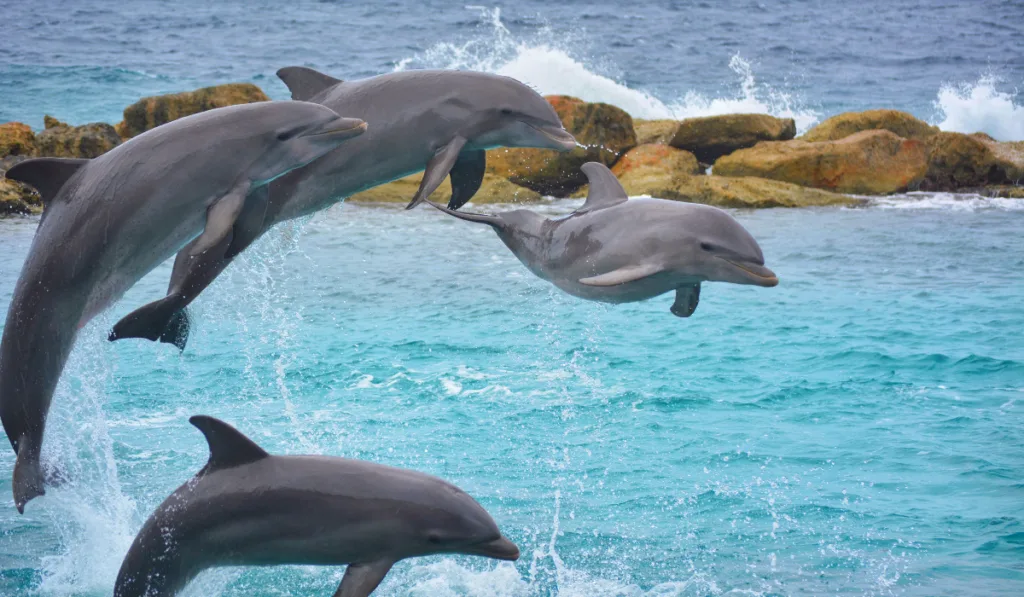
Oceanic dolphins are the largest family of dolphins with at least 38 known species. As revealed by their names, members of this family are found in water bodies like oceans and seas.
Oceanic dolphins belong to the Delphinidae family under the seven levels of classification. One distinguishing feature of the members of this family is their distinct beak.
Other features include at least 20 pairs of upper jaw teeth, fused cervical vertebrae, and a maximum length of 13 feet.
Killer Whale (Orca)
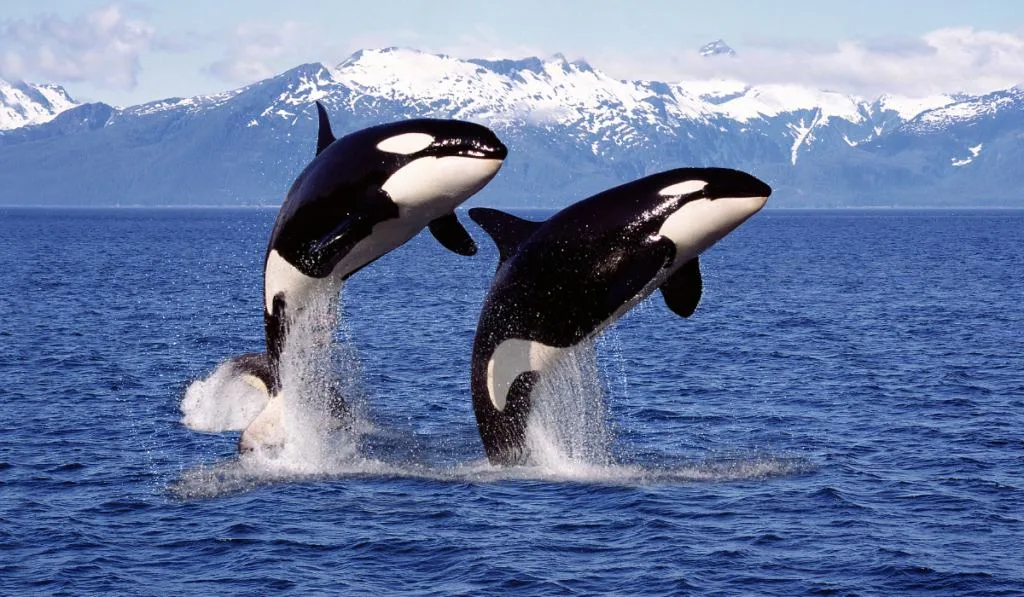
They don’t kill, they are not whales, but Killer Whales are the biggest dolphins in the world.
Male Orcas weigh as much as 22,046 pounds, while the females weigh around 16534 pounds. The males grow to be longer than the females, measuring 32 feet compared to the females (28 feet). The calves grow as big as 396 pounds and measure 8 feet in length.
They cover a broad habitat, including the Red Sea, the Gulf of Mexico, the Mediterranean Sea, the Persian Gulf, and the Gulf of California. Orcas are also found in more than 39 countries across various continents of the world.
Killer Whales have a pod size of up to 50 individuals, with the oldest female leading the pack. Orcas eat a wide variety of marine animals, including dolphins, fish, seals, sharks, octopi, whales, squids, and rays.
Killer Whales are migratory. But their migration is influenced by the availability of food. One interesting thing about Orcas is that each time they sleep, they do so with half of their brain.
There are currently 60 orcas in captivity.
Striped Dolphin
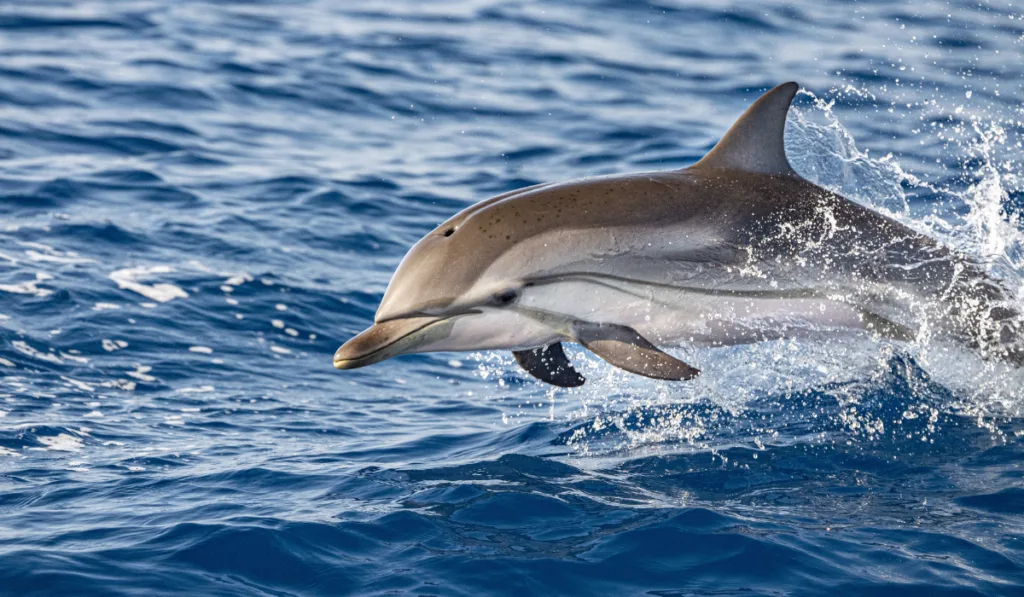
Striped Dolphins inhabit various oceans around the world, notably deep offshore waters. The males of this species grow as big as 352 pounds and 8.5 feet, while the females reach 330 pounds and 8 feet. Striped Dolphin calves can span up to 3.25 feet and weigh 22 pounds.
They live in groups of 100-500 individuals, and they feed on squids and smaller fish such as lantern-fish. A few Striped Dolphins have been successfully kept in captivity in Japan. But most efforts to keep them have failed.
Common Bottlenose Dolphin

Botlenose dolphins live in various oceans around the world besides the cold Antarctic and Arctic waters.
Some Common Bottlenose Dolphins are migratory, while some are not. Their diet is dependent on their habitat, but they are known to feed on salmons, crustaceans, and squids.
They commonly move in pods of 2-20 individuals. But on rare occasions, they move in thousands. Bottlenose Dolphins have individual names. They grow to be around 1433 pounds with the males having a max length of 12.5 feet and the females 12 feet. Baby Bottlenose Dolphins can grow as long as 4.25 feet.
There are as many as 1000 Common Bottlenose Dolphins in captivity.
Spinner Dolphin

Spinner Dolphins are so named because they spin and are highly acrobatic. They inhabit all subtropical and tropical waters in the world. They grow as big as 180 pounds; the females grow as long as 6.5, the males 7.7 feet, and the calves 2.6 feet.
The pod size of Spinner Dolphins can be as large as 200 individuals, and they eat small fishes, squids, and shrimps. They migrate vertically and horizontally, and they do well in captivity.
Hector’s Dolphin
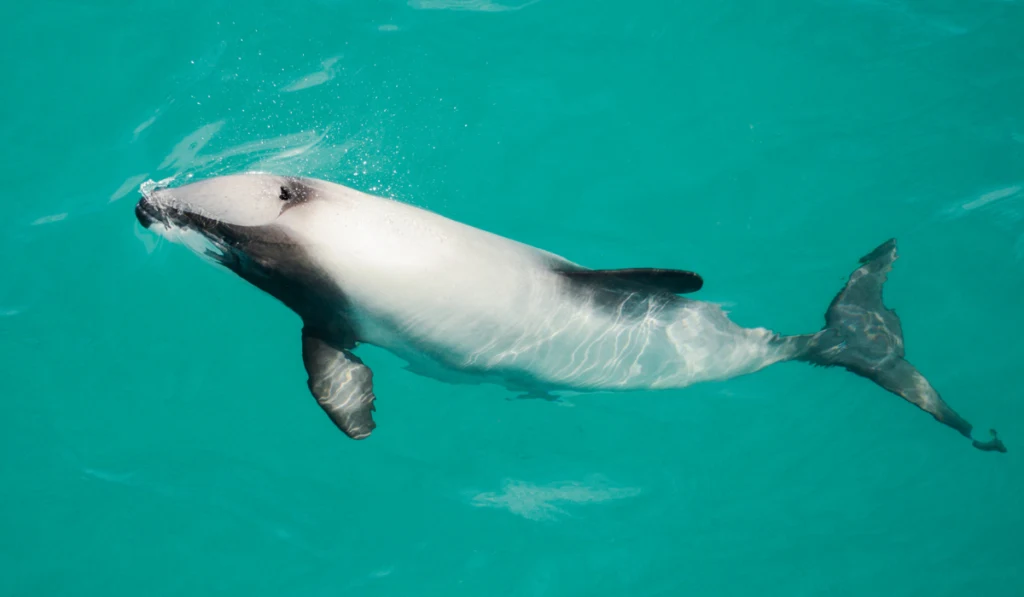
Hector’s Dolphins are the smallest and rarest marine dolphins in the world. They are found only in the coastal regions of New Zealand, and they move in pods of 2-10 individuals, and sometimes these pods merge into larger pods. They may later break the larger pods into smaller groups.
Female Hector’s Dolphins can be as long as 4.59 feet, while the males can be as long as 4.26 feet. The males weigh 132 pounds, while the females weigh 125 pounds. The calves grow as long as 2.6 feet and weigh 22 pounds.
Hector’s Dolphins eat coastal schooling fish such as stargazer, yellow-eyed mullet, and red cod. They also eat squids, and they hunt using echolocation.
Hector’s Dolphins may migrate during spring and summer.
Irrawaddy Dolphin

Irrawaddy Dolphins look very similar to baby belugas except that they have dorsal fins.
Irrawaddy Dolphins live in various coastal marine environments in Asia, including Indonesia, Southeast Asia, and the Bengal Bay. Peculiarly, some members of this species have been seen in freshwater environments, including the Mahakam River, the Chilka Lake, the Ayeyarwady River, and the Songkhla Lake.
Adult Irrawaddies grow as big as 286 pounds, while the calves weigh around 22 pounds. The males span 8.85 feet, the females 7.55 feet, and the calves 3.28 feet.
They usually move in pods of six, but groups of 25 have been seen. Irrawaddy Dolphins feed on any fish type available in their environment. They migrate between various habitats, and they are popular targets for captivity.
Short-Beaked Common Dolphin
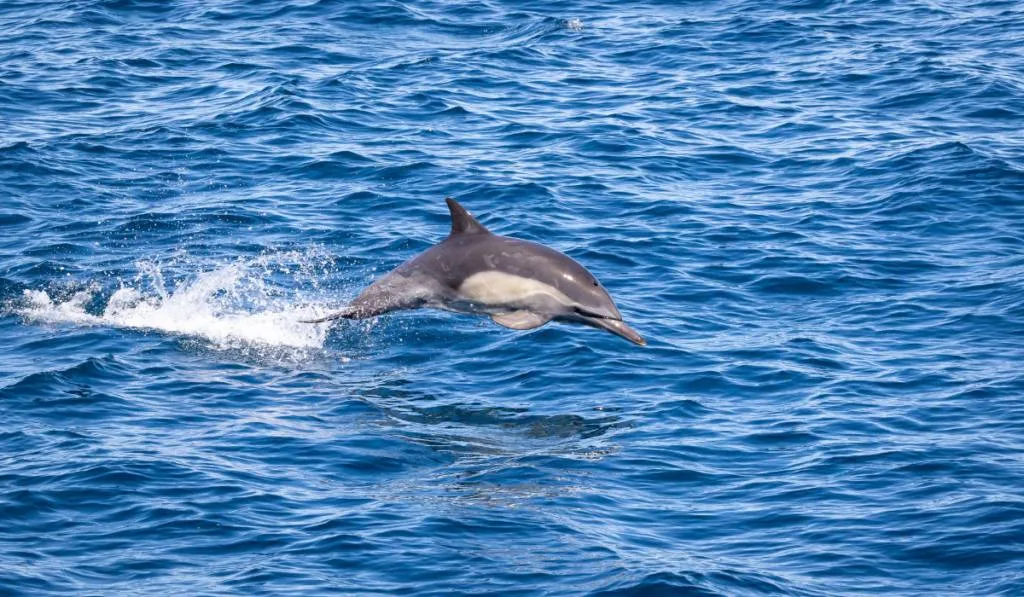
The Short-Beaked Common Dolphin is one of 2 recognized species of the Common Dolphin. They live in temperate and tropical waters of the Atlantic and the Pacific Oceans.
Female Short-beaked Common Dolphins grow as long as 8.53 feet, while the calves grow to be 2.62 feet long and 22 pounds. The males attain a maximum weight of 330 pounds and length of 8.85 feet.
They typically have a pod size of 10-50 individuals. Short-Beaked Common Dolphins eat various schooling fishes, including herrings, anchovies, sardines, hakes, and mackerels. They also eat octopi and squids.
Short-Beaked Common Dolphins are uncommon in captivity.
Long-Beaked Common Dolphin
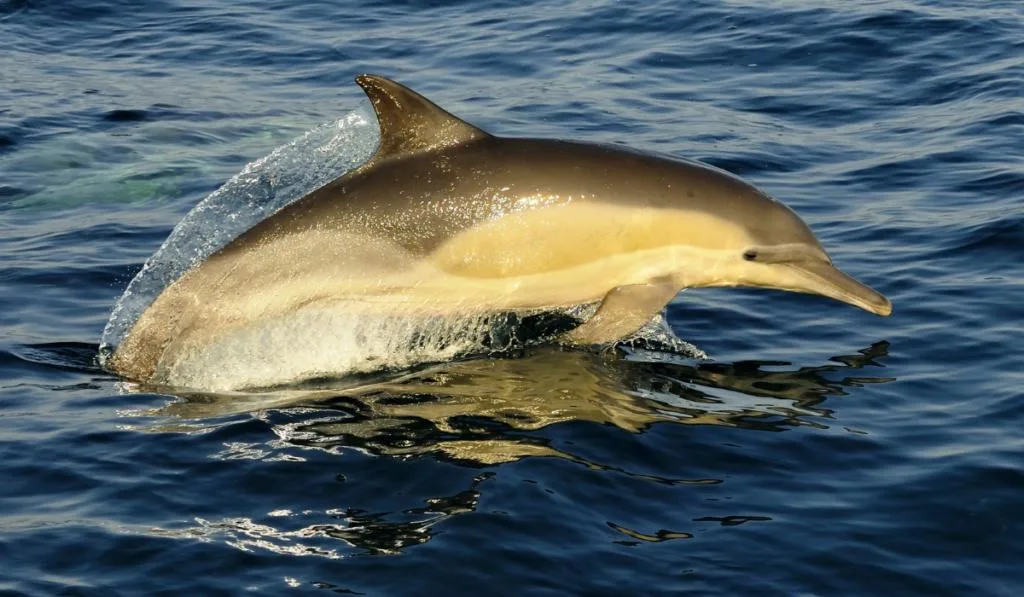
The Long-Beaked Common Dolphins are the second recognized Common Dolphin species. Adults of this species weigh 176-518 pounds, although commonly 330 pounds. The males are slightly longer than the females – 8.2 feet compared to 7.2 feet. The calves weigh 37 pounds and span 3.28 feet.
Long-Beaked Common Dolphins live in tropical and temperate regions of the Indian, Atlantic, and Pacific Oceans. They move in pods of 10-50 individuals, and they feed on a broad range of fishes like the Short-Beaked Common Dolphins.
Long-Beaked Common Dolphins are not common in captivity, and they have the highest number of teeth amongst dolphins.
It is thought that there might be a third Common Dolphin species called the Arabian Common Dolphin. But so far, this species is only recognized as a regional variety of the long-beaked common dolphin.
Risso’s Dolphin

Risso’s Dolphins live in virtually all the tropical and temperate waters in the world. They love eating squids, but they also eat shrimps, prawns, cuttlefishes, and other types of marine bodies. It all depends on the environment.
Risso’s Dolphins span 3.6-13.12 feet, with the adults weighing up to 1102 pounds. The calves, on the other hand, weigh as much as 44 pounds. Risso’s Dolphins are very social, and they move around in pods of up to 50 individuals.
The migration of Risso’s Dolphins is not well-studied. But they do migrate as they go after their prey. This species has been held captive in the USA and Japan, successfully.
Dusky Dolphin
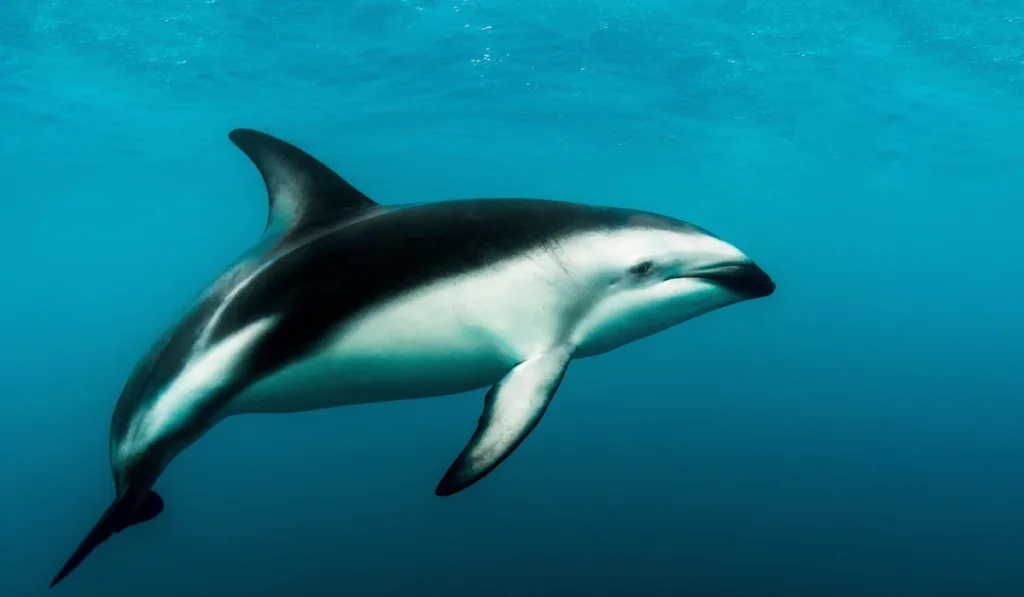
Dusky Dolphins span 3.28-6.88 feet, and they weigh as much as 187 pounds. They inhabit temperate and coastal waters across the Southern Hemisphere. Dusky Dolphins are divided into 4 subspecies, with each one separated by an ocean.
This species feeds on schooling fishes including sardines, anchovies, and mackerels. They commonly move in groups of 20. But sometimes, the pod size could be as large as 500-1000 or even 2000.
White-Beaked Dolphin
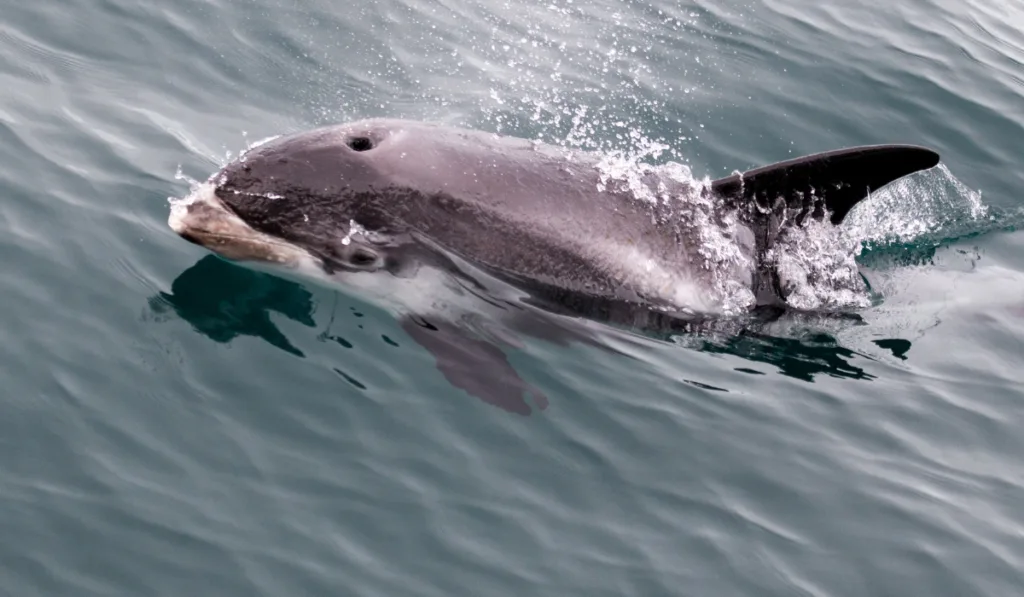
As the name hints, White-Beaked Dolphins have white beaks. They grow as big as 88-771 pounds and as long as 3.6-10.17 feet.
White-Beaked Dolphins are limited to cold and temperate waters of the northern region of the Atlantic Ocean. They move in pods of 5-50 individuals and feed on over 25 different species of marine animals, including squids, cods, crustaceans, and haddocks.
When winter comes, White-Beaked Dolphins migrate towards the south and further offshore.
Pacific White-Sided Dolphin
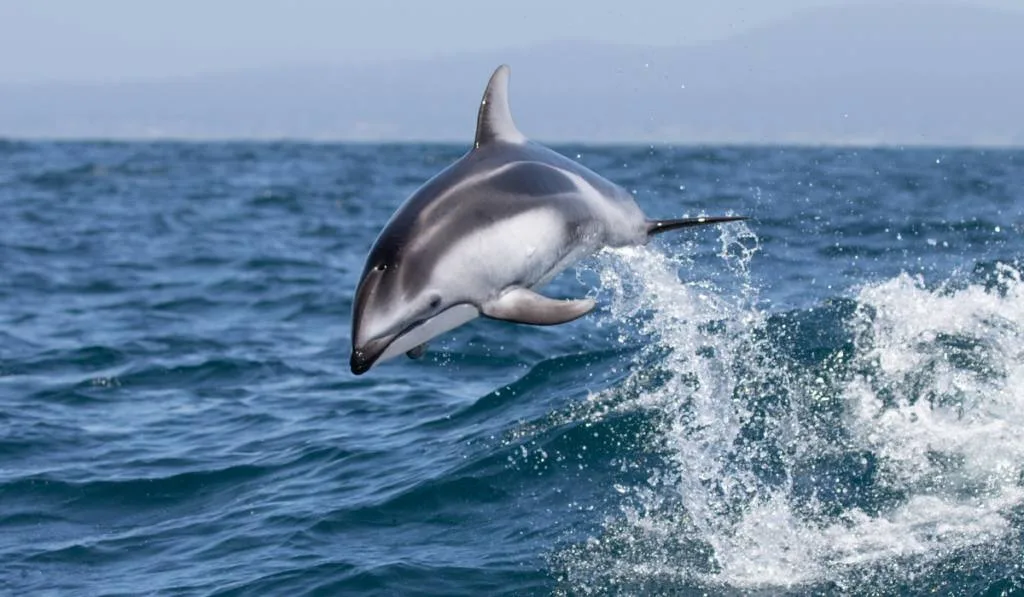
Pacific White-Sided Dolphins can be as long as 8.2 feet and as heavy as 440 pounds. They are found in the temperate North Pacific waters and associated seas.
They consume various prey, including schooling fishes and squids. Pacific White-Sided Dolphins move in pods of 10-100 individuals, but it could also be as many as 2000.
Pacific White-Sided Dolphins live in captivity, and they thrive too. When winter comes, members of this species move towards inshore waters.
Indo-Pacific Humpback Dolphin

These dolphins inhabit coastal waters of eastern Central China through south-east Asia and the Indian east coast. They grow as long as 3.28-9.18 feet and as heavy as 617 pounds.
This species feeds on various types of fishes depending on their environment. Indo-Pacific Humpbacks are not as social as most dolphins, and they usually move in pods of less than ten individuals.
Indo-Pacific Humpbacks migrate across the Pacific and Indian Oceans, and they are not commonly raised in captivity.
Indo-Pacific Bottlenose Dolphin
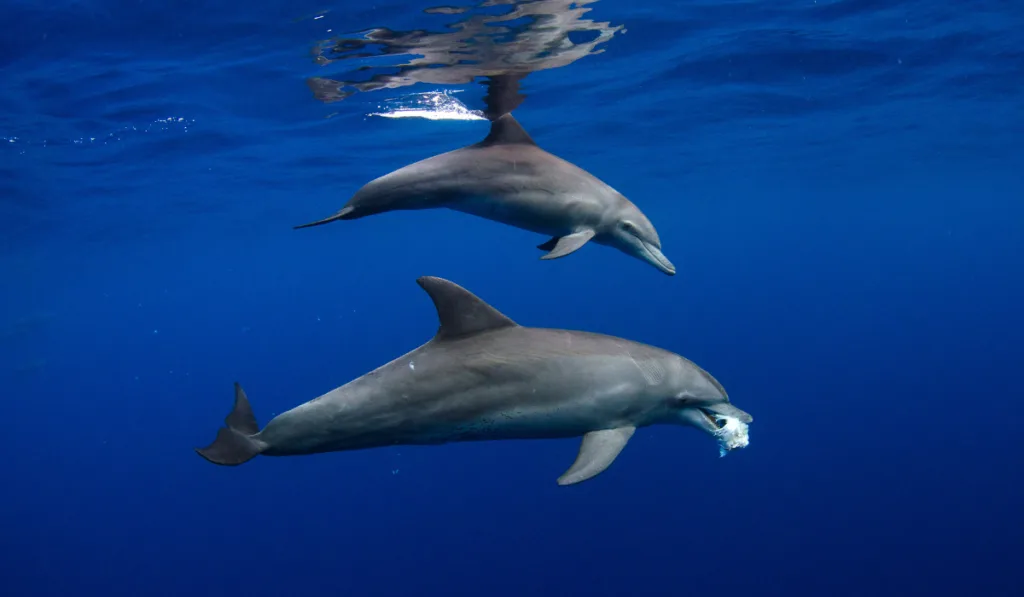
Indo-Pacific Bottlenose Dolphins span 3.6-8.85 feet, weighing 46-507 pounds. They typically live in tropical western Pacific and Indian Ocean waters. It is estimated that the population of Indo-Pacific Bottlenose Dolphins in oceans is around 6000.
Indo-Pacific Bottlenoses feed various types of species, with octopi and squids as their favorite. They commonly move in groups of 5-15 dolphins, and they are quite common in captivity.
Pantropical Spotted Dolphin

Pantropical Spotted Dolphins can be as big as 262 pounds and as long as 2.78-8.53 feet. They are commonly found in subtropical and tropical waters with a preference for waters with surface temperatures above 25°. They inhabit the Pacific, Indian, and Atlantic Oceans. They also live in the Red Sea and the Persian Gulf.
They feed on crustaceans, cephalopods, and schooling fishes. Their pod size varies largely; coastal pods commonly contain less than 100 individuals, while offshore pods can have as many as thousands.
Pantropical Spotted Dolphins are migratory, and a few are in captivity.
False Killer Whale
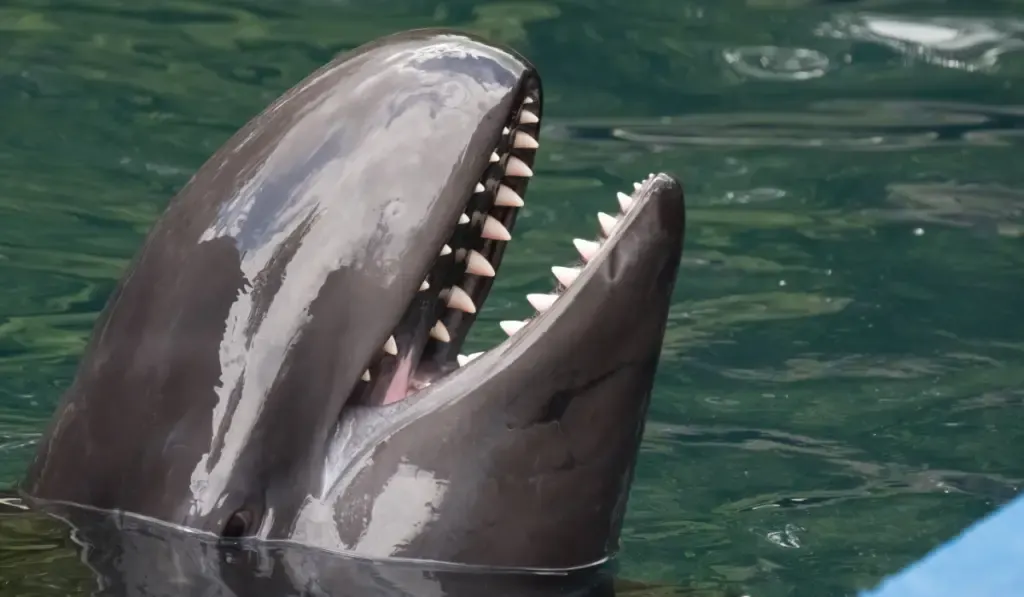
They might be called whales, but they are actually dolphins – one of the largest ones. False Killer Whales weigh around 2645-4850 pounds. They grow as long as 14.76-19.68 feet, and the babies span as much as 6.56.
False Killer Whales feed on fishes, squids, and smaller marine mammals. They move in groups of 10-40 individuals and inhabit tropical and warm temperate waters in various regions of the world.
It is not clear if False Killer Whales migrate. But a few of them are kept in captivity.
Commerson’s Dolphin
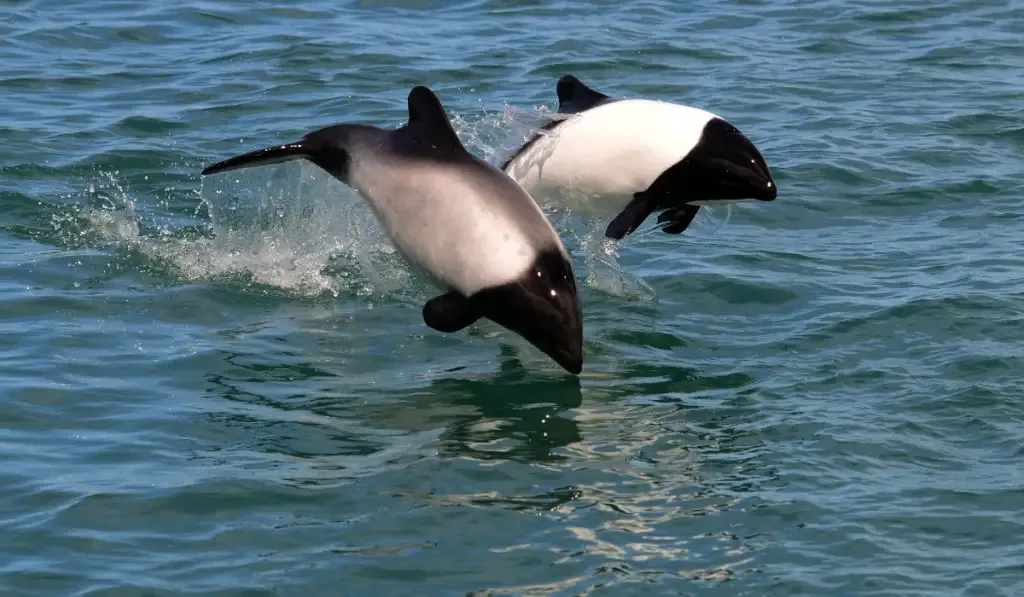
Commerson’s Dolphins have a peculiar black-and-white marking, and this earned them the name Panda Dolphins. They are small-sized dolphins weighing as much as 190 pounds and spanning lengths of 2.13-5.9 feet.
They live in cold waters close to shores. You may find them in coastal Argentina waters, coastal Kerguelen Islands waters, Falkland Islands coastal waters, and southernmost Chile coastal waters.
Commerson’s Dolphins usually move in pods of less than ten, but sometimes they could be as many as 100 individuals. They feed on schooling fishes, shrimps, seaweeds, squids, and marine worms.
There are a few Commerson’s Dolphins in captivity.
Long-Finned Pilot Whale
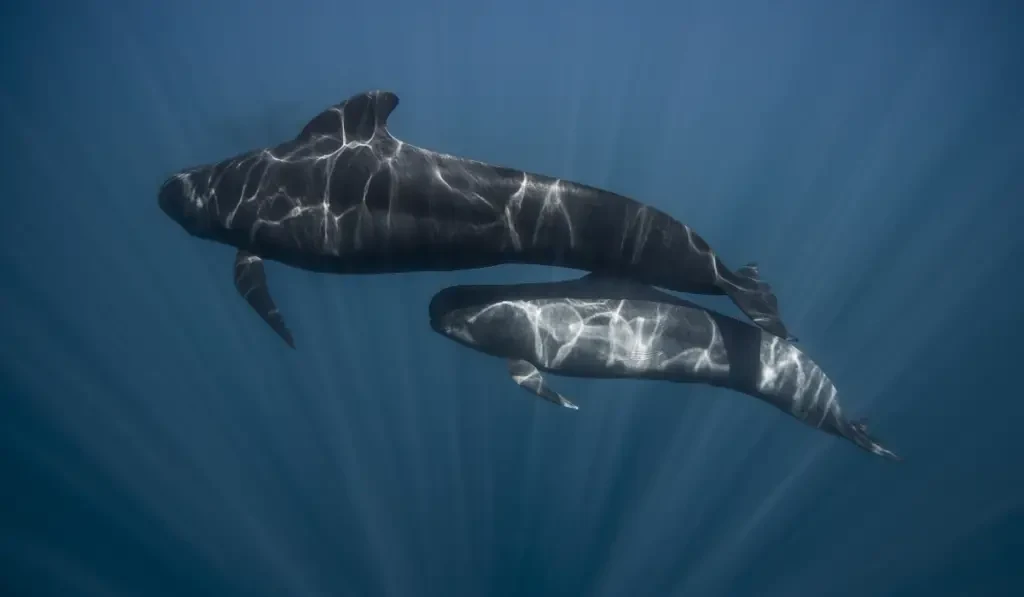
Long-Finned Pilot Whales are massive, weighing 2866-5070 pounds. The babies can be as long as 5.9 feet and as heavy as 220 pounds. The adults span 18.7-21.98 feet, and the females are generally longer.
Most times, they feed on cephalopods: octopi and squids. But they may also eat schooling fishes. Long-Finned Pilot Whales live in temperate and cold waters of the North Atlantic Ocean and the Southern Hemisphere.
They are migratory, and their movements are directed by sources of food. A pod can contain 10-20 individuals or even more.
Short-Finned Pilot Whale
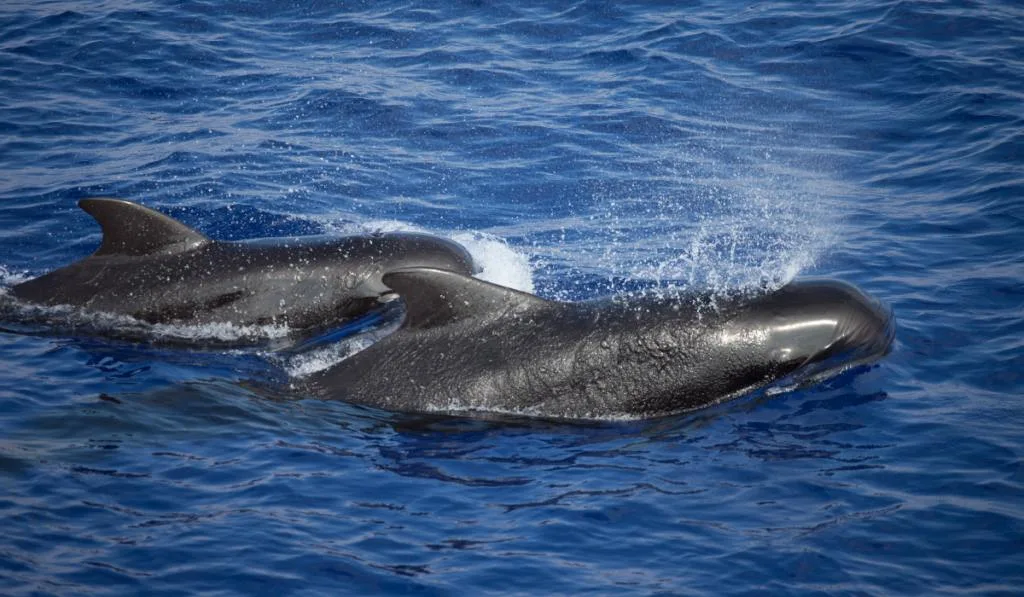
The Short-Finned Pilot Whales are classified as Pilot Whales like the Long-Finned variant. They live in temperate and tropical oceans around the world. Alongside the Long-Finned Pilot Whales, Short-Finned Pilot Whales are the second largest dolphins behind Orcas.
They grow as long as 18.04-18.7 feet and as heavy as 6613 pounds. Short-Finned Pilot Whales feed on schooling fishes and cephalopods. They move in pods of 10-50 individuals and migrate occasionally.
Short-Finned Pilot Whales have been kept in captivity in various parks. But they usually do not thrive.
Tucuxi

Tucuxis inhabit the Amazon basin, the Orinoco River, and various rivers in Peru, Brazil, Ecuador, and Colombia. Like the Irrawaddies, they are found in freshwater and coastal water. They grow as long as 4.92 feet and as big as 116 pounds.
Tucuxis feed on various crustaceans and freshwater fishes. Tucuxis in freshwater regions move in groups of 9-20, while those in coastal waters move in pods of up to 50 members.
Tucuxis do not thrive in captivity, and no significant migration has been seen in this species.
Chilean Dolphin
There may be less than 5000 members of this species left in the world. Chilean Dolphins are one of the smallest species of dolphins, and they inhabit Chilean coastal waters.
They span 3.28 feet as calves and up to 5.57 feet as adults. Adult Chilean Dolphins weigh around 138 pounds, and they feast on squids, fishes, and crustaceans.
Chilean Dolphin pods usually contain 2-15 individuals. They are typically non-migratory, or they migrate at low rates.
Fraser’s Dolphin
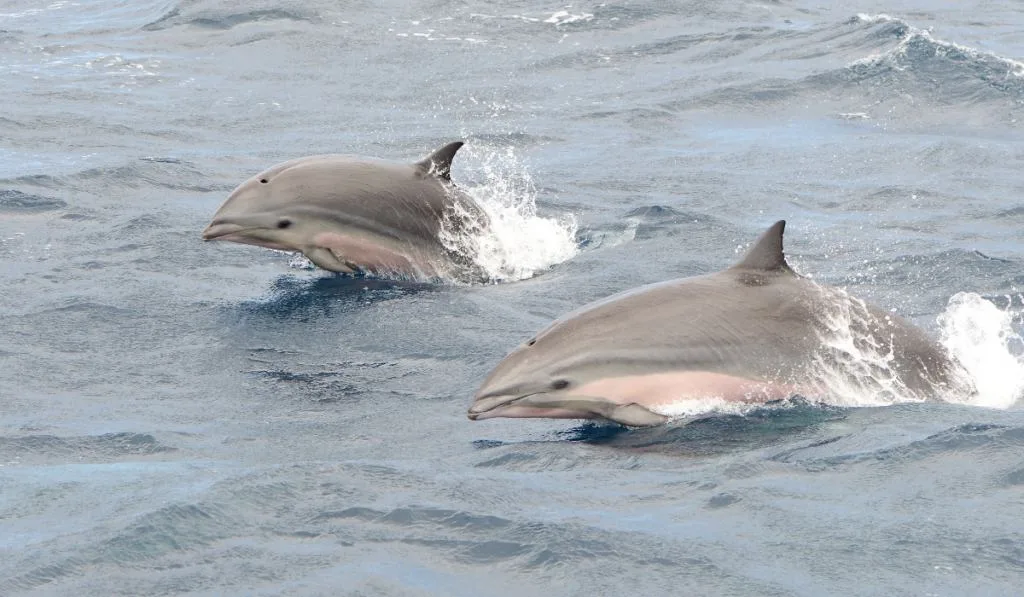
Fraser’s Dolphins inhabit 3 of the world’s major oceans: the Pacific, Indian, and Atlantic Oceans. The adults of this species grow as long as 8.53-8.85 feet and as big as 462 pounds. They move in pods of 100-500 individuals. But in rare cases, the pod could contain up to 1000 individuals.
Fraser’s Dolphins feed on fishes. But they supplement their diet with cephalopods and crustaceans.
Guiana Dolphin
Guiana Dolphins inhabit estuaries and shallow coastal waters around the Atlantic regions of central and South America. They may also be found around the coast of some Caribbean Islands.
Adult Guianas are as long as 6.23-7.21 feet, with a maximum weight of 266 pounds. They feed on crabs, squids, shrimps, and open-ocean fishes.
Guiana Dolphins move in cohesive pods of around 10-15 individuals. The pods can also be as small as 2-10 or as large as 20-30 individuals. While members of this species migrate, they usually only do so for short distances.
Rough-Toothed Dolphin
The Rough-Toothed Dolphins are so named because of the texture of the surface of their teeth. They live in warm-temperate, deep oceanic, and tropical waters of the Indian, Pacific, and Atlantic Oceans.
Adult Rough-Toothed Dolphins can weigh as much as 341 pounds while growing as long as 8.69-9.18 feet. The males are typically longer than the females. They eat large fishes, octopi, squids, smelts, and hound fishes.
They commonly have a pod size of 10-20, but larger ones of up to 160 individuals have been seen. Rough-Toothed Dolphins have survived being kept in captivity in Hawaii, a feat uncommon for oceanic dolphins.
Hourglass Dolphin
Hourglass Dolphins have a unique pattern on their sides that looks like an hourglass. They are commonly found in sub-Antarctic and Antarctic waters. The maximum length of an adult Hourglass Dolphin stands at 5.9-6.23 feet, and the females are usually longer than the males.
Adult Hourglass Dolphins can weigh as much as 264 pounds. They eat small fishes, squids, and crustaceans such as shrimps. Hourglass Dolphins commonly move in dozens, but they sometimes have a pod size of up to 100.
This species of dolphin is migratory, and they follow cold-water currents as the season changes.
Atlantic Spotted Dolphin
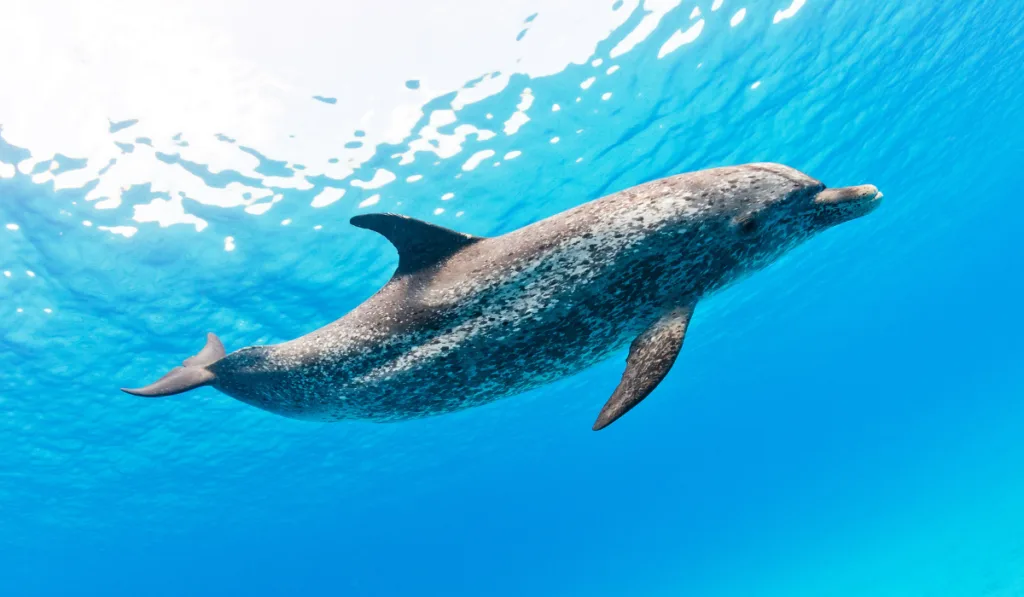
Atlantic Spotted Dolphins are great divers. They can hold their breath for up to ten minutes and dive as far as 196 feet. Atlantic Spotted Dolphins live in the Atlantic Ocean, particularly the tropical offshore regions. They grow as long as 7.54 feet and weigh as much as 315 pounds.
Atlantic Spotted Dolphins that stay in offshore areas move in pods of up to 100. On the other hand, those in coastal areas have groups of 5-15. They eat cephalopods, bottom-dwellers, and small fishes. This species is migratory.
Atlantic White-Sided Dolphin

Atlantic White-Sided Dolphins inhabit the North Atlantic Ocean, particularly the cold and temperate waters. The males are longer than the females, growing as long as 9.18 feet while the females only reach 8.2 feet. Adults of this species can weigh as much as 518 pounds.
They move in groups of 2-50 dolphins and feast on herrings, sand eels, cods, shrimps, and mackerels. Atlantic White-Sided Dolphins migrate seasonally.
Melon-Headed Whale
There are about 50,000 Melon-Headed Whales in the oceans. They commonly stay in deep subtropical waters, and they are usually seen in areas around the Hawaiian Islands.
The females hit a maximum length of 9.02 feet, while the males reach 8.69 feet. Melon-Headed Whales can grow as big as 606 pounds. They move in pods of hundreds and eat shrimps, small fishes, and squids.
Some Melon-Headed Whales are reported to be in captivity. But this species generally do not do well under such condition. They are, however, not known to be migratory.
Pygmy Killer Whale
Here’s another dolphin that does not kill and is not a whale. Pygmy Killer Whales stay around subtropical and tropical waters of the Indian, Pacific, and Atlantic Oceans. The adults grow as long as 6.88-8.53 feet and they weigh 374-496 pounds.
Pygmy Killer Whales eat various types of fishes and squids. Their pod size ranges from 1 to 30 individuals, but it can also be as large as 100. Some Pygmy Killer Whales have been kept in captivity in the past, but most of them died within days.
Peale’s Dolphin
Peale’s Dolphins are typically found in the southern coastal waters of South America. They eat octopi, squids, crustaceans, and fishes. Peale’s Dolphins have lengths of 6.88-7.21 feet and a maximum weight of 253 pounds.
They commonly move in pods of up to 20 dolphins, although this could be higher. While their migration patterns are not known, it is thought that they follow the movements of their prey.
Australian Snubfin Dolphin
Australian Snubfin Dolphins inhabit northern and eastern Australian coasts up to the Papua coast in New Guinea. They grow 7.21-8.85 feet long and weigh 286 pounds.
Australian Snubfin Dolphins feed on cephalopods, small fishes, and shrimps. They swim and hunt in pods of 5-14 dolphins. Australia Snubfin Dolphins are migratory.
Heaviside’s Dolphin

Heaviside’s Dolphins were discovered by Captain Haviside around the South African coast. But he was misidentified. The discoverer was thought to be a Captain John Heaviside instead. Hence, the name Heaviside’s Dolphin. Even with the error, some still refer to them as Haviside’s Dolphins.
This species is found in the cold temperate seas of western South Africa, southern Angola, and Namibia. They are non-fussy eaters, which feed on various prey, including octopi, gobies, squids, and horse mackerels.
Heaviside’s Dolphins commonly move in pods of 2-3 individuals. However, they do not migrate. Heaviside’s grow as long as 5.7 feet, weighing up to 165 pounds.
Clymene Dolphin
Clymene Dolphins inhabit subtropical and tropical regions of the Atlantic Ocean. They may also be found in New Jersey, Mauritania, and southern Brazil. They have a length range of 6.23-6.56 feet and weights of up to 176 pounds.
Clymene Dolphins feed on small fishes and cephalopods. They move in pods of up to 50, and sometimes, you may find them with Spinner dolphins and Common dolphins.
This species migrates based on the pattern of their prey’s migration.
Northern Right Whale Dolphin
One unique feature of the Northern Right Whale Dolphins is the absence of a dorsal fin. This species of dolphins are commonly found in temperate offshore waters of the North Pacific Ocean.
The adult males grow as long as 10.17 feet, while the females reach lengths of 7.54-8.53 feet. Adult Northern Right Whale Dolphins weigh between 132 and 200 pounds.
They move in groups of 100-200 and eat marine animals like hakes, squids, lanternfishes, and various other midwater and surface water fishes.
Northern Right Whale Dolphins migrate within their habitat based on temperature changes.
Southern Right Whale Dolphin
Like their Northern counterparts, Southern Right Whale Dolphins do not have dorsal fins. They are found in a circumpolar range in the temperate southern hemisphere waters towards the north of the Antarctic convergence.
Adult Southern Right Whale Dolphins grow as long as 5.9-9.51 feet, and they weigh 132-255 pounds. They eat various types of fishes and squids and move in pods of less than 100. Occasionally, you may find pods of up to 1000.
Members of this species do not usually thrive in captivity.
Atlantic Humpback Dolphin

Adult Atlantic Humpback Dolphins weigh up to 573 pounds. and grow as long as 8.53 feet. They live in shallow coastal waters around the West African coast and have been found in all West African countries.
Atlantic Humpback Dolphins swim in pods of up to 25 individuals although pods of 5-7 dolphins are more common. Their diet is not well-studied, but they are known to feed on fishes.
Australian Humpback Dolphin
As suggested by their names, the Australian Humpback Dolphins inhabit estuaries and coastal waters on the northern Australian coast. They can grow as long as 8.53-9.18 feet while weighing 617 pounds.
Members of this species are opportunistic feeders, and they eat various types of fishes. Australian Humpbacks commonly move in pods of 1-3 dolphins.
Indian Ocean Humpback Dolphin
The third in our list of humpback dolphins are the Indian Ocean Humpback. As you would expect, these dolphins inhabit the Indian Ocean, particularly the nearshore waters. The adults grow as long as 5.9-8.53 feet and weigh a maximum of 617 pounds.
Indian Ocean Humpback Dolphins move in large pods. They are opportunistic feeders that eat fishes like sardines, mullets, and mackerels.
River Dolphins
Unlike Oceanic Dolphins, River Dolphins live in estuaries and freshwater rivers. This group consists of 4 families, including Baiji, Amazon River Dolphin, La Plata Dolphins, and South-Asian River Dolphins.
Baiji, Amazon River Dolphin, and South-Asian River Dolphins live in freshwater rivers, while La Plata Dolphins live in estuaries.
Amazon River Dolphin
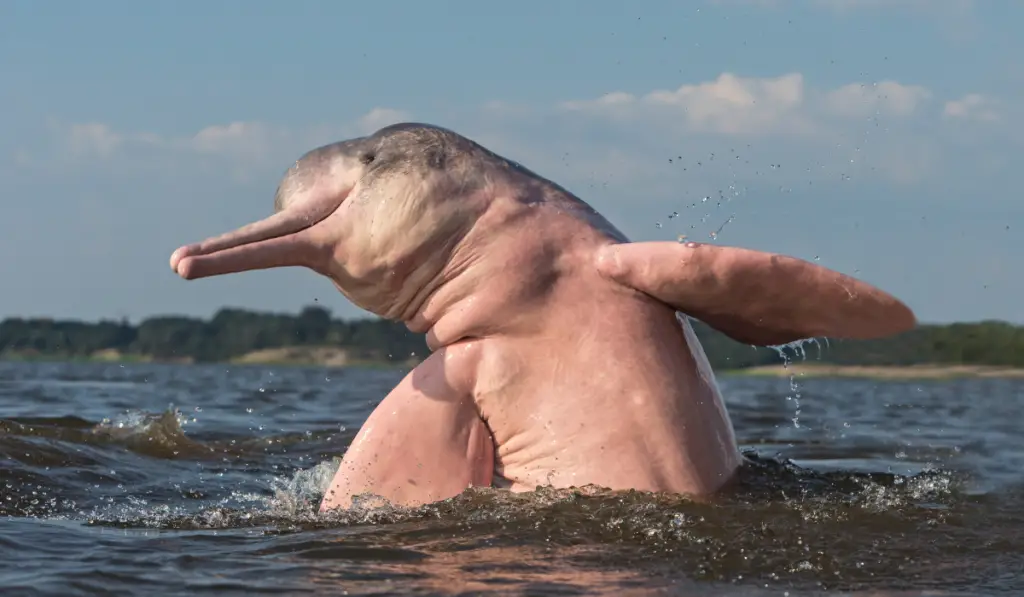
As the name indicates, the Amazon River Dolphin is located in the river systems of the Amazon. They may also be found in flooded South American rainforests and Orinoco river systems.
Amazon River dolphins can weigh as much as 456 pounds with the males growing as long as 9.18 feet. Female Amazon River dolphins typically grow as long as 7.54 feet, while the calves are usually around 2.62 feet long.
Amazon River dolphins have a pod size of 3-4 individuals. But sometimes they move alone, while in other cases, they move in mother-calf pairs.
Amazon River dolphins commonly eat crabs, shrimps, turtles, and over 40 fish species. Interestingly, they are the only dolphins with molar teeth comparable to what humans have.
Botos are migratory, and their migration pattern is mainly influenced by water levels. Although in some cases, gender and age also play a part in their migration preferences.
Currently, there are only 3 of this species in captivity: one each in Germany, Peru, and Venezuela.
Araguaian River Dolphin
The Araguaian River Dolphin is classified as an Amazon River Dolphin. But recently, a study discovered that there might be a few differences between the two species.
The said study is debated, and so far, the Society for Marine Mammalogy has not recognized the Araguaian River Dolphin as a separate species.
Baiji
Baijis have most likely gone into extinction. They were commonly found around water bodies in China, including the Yangtze River, Qiantang River, Dongting Lake, and Poyang Lake.
Baijis weighed 300-507 pounds and the females averaged about 8.2 feet in length, while the males averaged 7.54 feet. The longest Baiji was recorded to have been as long as 8.85 feet.
Baijis fed on various types of small fishes. They have a small pod size; they move in pairs or in groups of 3-4 dolphins. Records show that a pod size of 16 dolphins has been recorded.
South-Asian River Dolphins
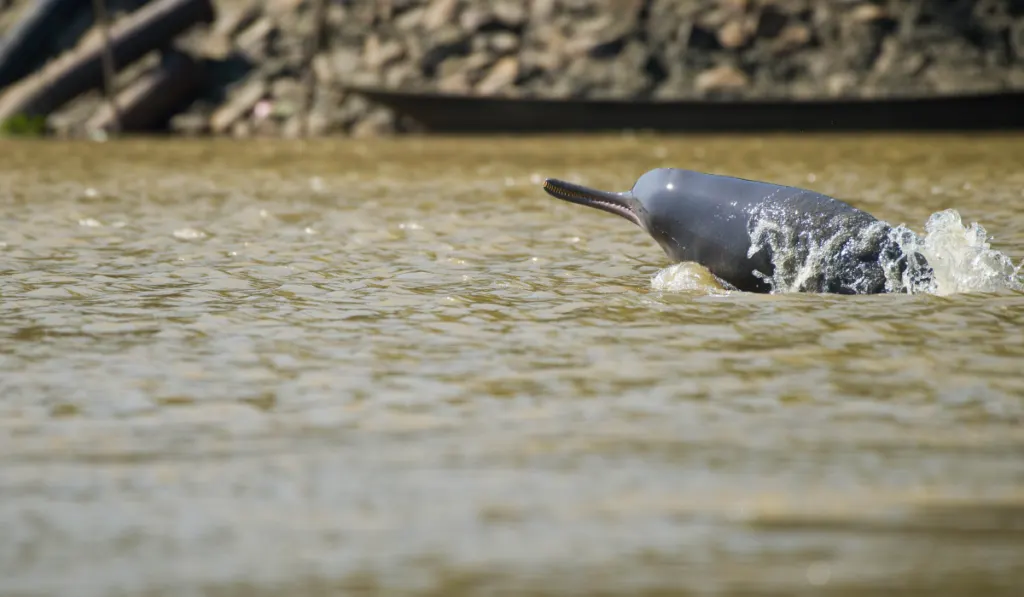
South-Asian River Dolphins are divided into 2 subspecies: Ganges River Dolphin and Indus River Dolphin.
The Indus River Dolphin is found in the Indus River. On the other hand, the Ganges River Dolphin is found around the Ganges water system.
Ganges River Dolphins typically measure 6.56-7.21 feet with a weight range of 112-196 pounds. The Indus have bigger females that measure 7.87-8.53 feet, while the males measure 6.56-7.21 feet. Indus River Dolphins weigh 155-245 pounds.
South Asian River Dolphins are loners, but they sometimes move in groups. The groups could be 2-3 individuals or up to ten members in the case of a Ganges River Dolphin.
South Asian River Dolphins are carnivores. They eat various types of fishes, carps, prawns, shrimp, turtles, and gobio. In some cases, Gangers River Dolphin might even eat birds.
South Asian River Dolphins are migratory.
La Plata Dolphin (Franciscana)
Female La Plata Dolphins are usually longer than their male counterparts. They measure 8.9 feet, while the males 5.24 feet. On average, they weigh around 110 pounds.
La Plata Dolphin is unevenly distributed across the eastern South American region of the Atlantic Oceans. They eat crustaceans, cephalopods, and fishes. La Plata Dolphins move in groups of 2-15. But their pod size can be as large as 20-40.
La Plata Dolphins are migratory.
Porpoises
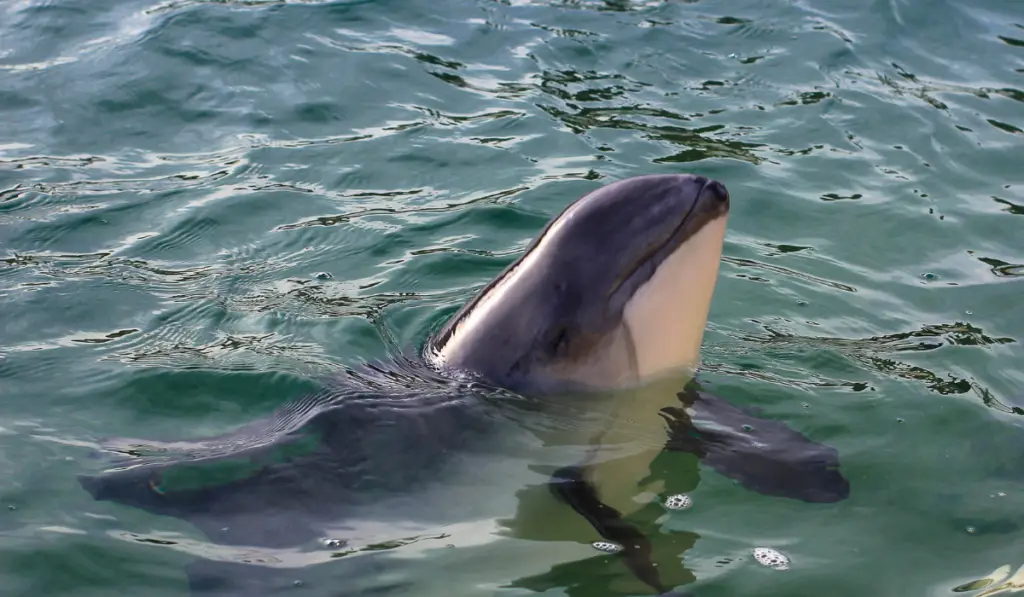
Porpoises are dolphin look-alikes. Although they have blunt heads, blunt teeth, small or no beaks, and are smaller than dolphins.
While they have some physical differences, dolphins and porpoises have similar mental prowess, and they are both mammals.
There are currently seven species of porpoises in the world, and none of them measures longer than 8.2 feet. We discuss them below.
Harbor Porpoise
Harbor porpoises inhabit temperate waters of the North Pacific and North Atlantic. They also live in coastal sub-Arctic waters and the northwest African coast.
The males grow to be as long as 5.9 feet weighing 134 pounds, while the females grow as long as 6.23 feet weighing 167 pounds. The calves have an average length of 2.29 feet.
Harbor porpoises eat small fishes such as sand eels, herring, and sprat. They also eat cephalopods such as octopi and squids.
Like most other porpoise species, harbor porpoises mature quickly. They start breeding even before they reach three years of age.
Harbor porpoises commonly move on their own, but sometimes they move in small groups. More commonly, you’ll find mothers and babies together.
Evidence of north-south migrations has been found amongst harbor porpoises. Over time, more than 150 have been kept in captivity, and some were even born in captivity.
Indo-Pacific Finless Porpoise

Indo-Pacific Finless Porpoises are found in waters that run through the southern East China Sea, the Indian Ocean, and the Persian Gulf.
Adults Indo-Pacific Finless Porpoises grow as long as 6.56 feet and weigh 121 pounds, while the calves grow as long as 2.46 feet. They are shy, and they move alone or in small groups.
Indo-Pacific Finless Porpoises feed on bottom dwellers: bottom-dwelling fishes, shrimps, octopi, crabs, and squids.
Narrow-Ridged Finless Porpoise
Females of this species are larger than the males, weighing 132 pounds against the maximum male weight of 121 pounds. Both male and female adults can grow as long as 6.56 feet, while the calves can reach a length of 2.46 feet.
Narrow-Ridged Finless Porpoises can be found in the Yangtze River and associated estuaries and lakes. For this reason, they are sometimes called Yangtze Finless Porpoise. They can also be found in the Taiwan Strait through the Yellow Sea, through Southern Japan.
Narrow-Ridged Finless Porpoises have a diet similar to that of the Indo-Pacific Finless Porpoises. They feed on shrimps, crabs, squids, octopi, cuttlefishes, and bottom-dwelling fishes. They move alone or in groups containing up to 50 individuals.
Some members of this species have been kept in captivity. However, in our search, we could not ascertain specific details.
Vaquita
Amidst the cetaceans, Vaquitas are the most endangered. There are just 10 of them left in the world.
Vaquitas inhabit a small portion of the Sea of Cortez in the upper Gulf of California. They grow to be about 110 pounds with the females having a length of 4.92 feet while the males grow as long as 4.75 feet. The calves grow to be as long as 2.62 feet.
Vaquitas eat fishes, crabs, lobsters, squids, and other typical food porpoises eat. There are currently no Vaquita in captivity.
Spectacled Porpoise
Spectacled Porpoises are quite large; they weigh around 253 pounds, with the females having a maximum length of 6.72 feet and the males 7.38 feet. The calves grow as long as 3.28 feet.
Spectacled Porpoises inhabit the south-eastern coast of South America. But they’ve also been seen in cold sub-Arctic waters and oceanic waters around the Tasmanian coast and offshore islands.
This species is not as known as other species. They are fast swimmers, shy, and not very acrobatic. Spectacled Porpoises move in groups of 1-5 individuals, and they have been noted to eat shrimps and anchovies.
Only one spectacled porpoise has been kept in captivity, and it died a few days after. Before it was captured, the said spectacled porpoise was stranded.
Dall’s Porpoise
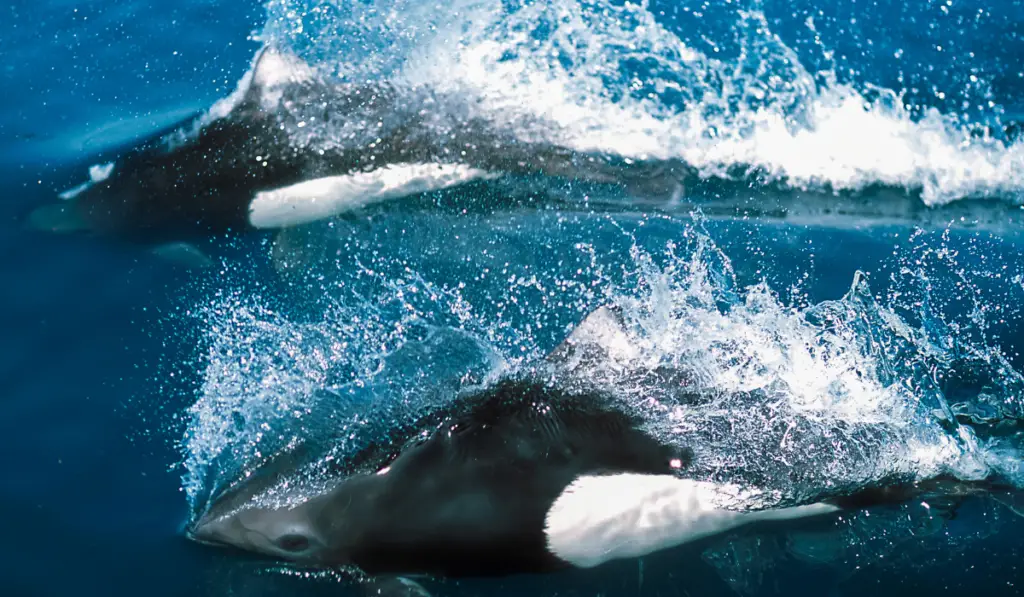
Dall’s Porpoises are the largest, and they are considerably fast too, reaching speeds up to 35 mph. They inhabit the North Pacific Ocean and associated waters, including the central Bering Sea and seas from southern Japan and southern California.
Adult Dall’s Porpoises weigh up to 440 pounds, with the males growing as long as 7.87 feet and the females 7.21 feet. The calves span up to 3.28 feet.
Dall’s Porpoises commonly move in groups of up to 12 individuals. But sometimes, the groups could have hundreds of individuals. They are opportunistic eaters that feed on squids, shrimps, octopi, crabs, and a wide range of fishes living close to the water’s surface.
While some Dall’s Porpoises have been kept in captivity in the past, they barely thrived. Most of them die within a few days, while only 2 lived longer than 60 days.
Burmeister’s Porpoise
Burmeister’s Porpoises are quite stealthy, so not much is known about them. They have been found around the Pacific coast of northern Peru and around the Atlantic coast of southern Brazil. But there is no certainty about their range since they are elusive.
Female Burmeister’s grow as long as 5.9 feet and weigh 187 pounds. The males hit a maximum length of 6.56 feet, while the calves can hit 2.62 feet max.
Burmeister’s Porpoises move alone, in pairs, or in groups of up to ten individuals. With their elusiveness, not much is known about their diet, but they are thought to consume smaller fishes, shrimps, and squids.
Like the spectacled porpoise, only a single Burmeister’s porpoise has been kept in captivity. It was captured after being stranded, and it died a few days after.
Extinct Dolphins
The following dolphin species existed at one point, but they are now extinct:
- Orcinus Paleorca
- Stenella Rayi
- Australodelphis Mirus
Resources
- https://us.whales.org/whales-dolphins/facts-about-dolphins/
- https://www.nbcnews.com/id/wbna35013555
- https://us.whales.org/whales-dolphins/river-dolphins/
- https://us.whales.org/whales-dolphins/porpoises/
- https://us.whales.org/whales-dolphins/species-guide/amazon-river-dolphin/
- http://animaldiversity.org/site/accounts/information/Inia_geoffrensis.html
- https://web.archive.org/web/20150402113858/http://www.iucn-csg.org/wp-content/uploads/2010/03/Brauliketal2005.pdf
- http://www.animalinfo.org/species/cetacean/lipovexi.htm
- https://www.dolphins-world.com/chinese-river-dolphin/
- https://www.worldwildlife.org/species/indus-river-dolphin
- https://www.dolphins-world.com/ganges-river-dolphin/
- https://www.dolphins-world.com/indus-river-dolphin/
- https://www.ncbi.nlm.nih.gov/pmc/articles/PMC4235892
- https://www.dolphins-world.com/la-plata-river-dolphin/
- http://www.sci-news.com/biology/science-inia-araguaiaensis-river-dolphin-brazil-01714.html
- https://us.whales.org/whales-dolphins/species-guide/harbour-porpoise/
- https://portals.iucn.org/library/sites/library/files/documents/RD-1991-001.pdf
- https://us.whales.org/whales-dolphins/species-guide/narrow-ridged-finless-porpoise/
- http://us.whales.org/whales-dolphins/species-guide/indo-pacific-finless-porpoise/
- https://us.whales.org/whales-dolphins/species-guide/vaquita/
- https://us.whales.org/whales-dolphins/species-guide/spectacled-porpoise/
- https://porpoise.org/about-porpoises/spectacled-porpoise/
- https://dolphinproject.com/blog/wayback-machine-dalls-porpoises-in-captivity/
- https://portals.iucn.org/library/sites/library/files/documents/RD-1991-001.pdf
- https://us.whales.org/whales-dolphins/species-guide/dalls-porpoise/
- https://us.whales.org/whales-dolphins/species-guide/burmeisters-porpoise/
- https://www.dolphins-world.com/killer-whale/
- https://us.whales.org/whales-dolphins/species-guide/orca-killer-whale/
- https://www.acsonline.org/orca–killer-whale-
- https://www.dolphins-world.com/striped-dolphin/
- https://us.whales.org/whales-dolphins/species-guide/striped-dolphin/
- https://www.dolphins-world.com/bottlenose-dolphin/
- https://us.whales.org/whales-dolphins/species-guide/common-bottlenose-dolphin/
- https://www.fisheries.noaa.gov/species/spinner-dolphin
- https://us.whales.org/whales-dolphins/species-guide/spinner-dolphin/
- https://www.acsonline.org/spinner-dolphin?
- https://www.dolphins-world.com/hectors-dolphin/
- https://us.whales.org/whales-dolphins/species-guide/hectors-dolphin/
- https://animaldiversity.org/accounts/Cephalorhynchus_hectori/
- https://us.whales.org/whales-dolphins/species-guide/irrawaddy-dolphin/
- http://www.crdt.org.kh/irrawaddy-dolphin-conservation/
- https://us.whales.org/whales-dolphins/species-guide/short-beaked-common-dolphin/
- https://www.dolphins-world.com/short-beaked-common-dolphin/
- https://us.whales.org/whales-dolphins/species-guide/long-beaked-common-dolphin/
- https://www.dolphins-world.com/long-beaked-common-dolphin-delphinus-capensis/
- https://us.whales.org/whales-dolphins/species-guide/rissos-dolphin/
- https://us.whales.org/whales-dolphins/species-guide/dusky-dolphin/
- https://www.fisheries.noaa.gov/species/white-beaked-dolphin
- https://us.whales.org/whales-dolphins/species-guide/white-beaked-dolphin/
- http://kids.nceas.ucsb.edu/mmp/pacwhitsidedolphin.html
- https://savethewhales.org/indo-pacific-humpback-dolphin/
- https://us.whales.org/whales-dolphins/species-guide/indo-pacific-humpback-dolphin/
- https://www.dolphins-world.com/chinese-white-dolphin/
- https://us.whales.org/whales-dolphins/species-guide/indo-pacific-bottlenose-dolphin/
- http://animalia.bio/pantropical-spotted-dolphin
- https://us.whales.org/whales-dolphins/species-guide/pantropical-spotted-dolphin/
- https://us.whales.org/whales-dolphins/species-guide/false-killer-whale/
- https://www.dolphinproject.com/blog/captive-commersons-dolphins-in-north-america/
- https://us.whales.org/whales-dolphins/species-guide/commersons-dolphin/
- https://us.whales.org/whales-dolphins/species-guide/long-finned-pilot-whale/
- https://whaleopedia.org/oceanic-dolphins/tucuxi-dolphin
- https://www.dolphins-world.com/tucuxi-sotalia-fluviatilis/
- https://us.whales.org/whales-dolphins/species-guide/tucuxi/
- https://us.whales.org/whales-dolphins/species-guide/short-finned-pilot-whale/
- https://www.ncbi.nlm.nih.gov/pmc/articles/PMC4405423/
- https://us.whales.org/whales-dolphins/species-guide/chilean-dolphin/
- https://us.whales.org/whales-dolphins/species-guide/frasers-dolphin/
- https://www.sciencedirect.com/science/article/abs/pii/S2352485519302932
- https://www.dolphins-world.com/guiana-dolphin/
- https://us.whales.org/whales-dolphins/species-guide/guiana-dolphin/
- https://oceanwide-expeditions.com/blog/meet-the-hourglass-dolphin
- https://us.whales.org/whales-dolphins/species-guide/hourglass-dolphin/
- https://www.azoreswhalewatch.com/sightings/cetaceans/atlantic-spotted-dolphin-fun-facts
- https://us.whales.org/whales-dolphins/species-guide/atlantic-spotted-dolphin/
- https://marinebio.org/species/atlantic-white-sided-dolphins/lagenorhynchus-acutus/
- https://us.whales.org/whales-dolphins/species-guide/atlantic-white-sided-dolphin/
- https://www.dolphinproject.com/blog/taiji-seasons-first-hunt-of-melon-headed-whales/
- https://us.whales.org/whales-dolphins/species-guide/melon-headed-whale/
- https://us.whales.org/whales-dolphins/species-guide/pygmy-killer-whale/
- https://www.dolphins-world.com/pygmy-killer-whale/
- https://www.dolphins-world.com/peales-dolphin/
- https://us.whales.org/whales-dolphins/species-guide/peales-dolphin/
- https://www.dolphins-world.com/australian-snubfin-dolphin-orcaella-heinsohni/
- https://us.whales.org/whales-dolphins/species-guide/australian-snubfin-dolphin/
- https://us.whales.org/whales-dolphins/species-guide/heavisides-dolphin/
- https://us.whales.org/whales-dolphins/species-guide/clymene-dolphin/
- https://us.whales.org/whales-dolphins/species-guide/atlantic-humpback-dolphin/
- https://www.dolphins-world.com/atlantic-humpback-dolphin-sousa-teuszii/
- https://us.whales.org/whales-dolphins/species-guide/australian-humpback-dolphin/
- https://us.whales.org/whales-dolphins/species-guide/indian-ocean-humpback-dolphin/
- https://www.fisheries.noaa.gov/species/northern-right-whale-dolphin
- https://www.dolphins-world.com/northern-right-whale-dolphin-lissodelphis-borealis/
- https://us.whales.org/whales-dolphins/species-guide/northern-right-whale-dolphin/
- https://animaldiversity.org/accounts/Lissodelphis_peronii/
- https://www.dolphins-world.com/southern-right-whale-dolphin-lissodelphis-peronii/
- https://us.whales.org/whales-dolphins/species-guide/southern-right-whale-dolphin/
